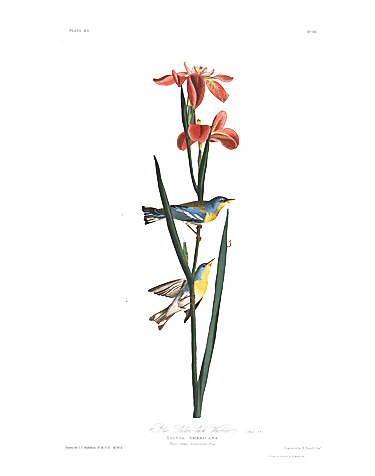|
Havell Name
Blue Yellow back Warbler Common Name Northern Parula Havell Plate No. 015 Paper Size 39" x 28" Image Size 14" x 4" Price $ 800 |
||||
|
Ornithological Biography This pretty species enters Louisiana from the south as early as spring appears, at the period when most insects are found closer to the ground, and more about water-courses, than shortly after, when a warmer sun has invited every leaf and blossom to hail the approach of that season when they all become as brilliant as nature intended them to be. The little fellow under your eye is then seen flitting over damp places, such as the edges of ponds, lakes, and rivers, chasing its prey with as much activity and liveliness as any other of the delicate and interesting tribe to which it belongs. It alights on every plant in its way, runs up and down it, picks here and there a small winged insect, and should one, aware of its approach, fly off, pursues it and snatches it in an instant.
I have placed a pair of these Warblers on a handsome species of iris. This plant grows in the water, and in the neighbourhood of New Orleans, a few miles below that city, where I found it abundantly, and in bloom, in the beginning of April. Several flowers are produced upon the same stem. I have not met with it anywhere else, and the name of Louisiana flag is the one commonly given it. As soon as the foliage of the forests begins to expand, the Blue Yellow-backed Warbler flies to the tops of the trees, and there remains during the season, gleaning amongst the leaves and branches, in the same active manner as it employed when nearer the ground, not leaving off its quick and short pursuit of small insects on the wing. When on the branches, it frequently raises its body (which is scarcely larger when stripped of its feathers than the first joint of a man’s finger) upwards to the full length of its legs and toes, and is thus enabled to seize insects otherwise beyond its reach. Its flight is that of a true Sylvia. It ascends for awhile in a very zigzag manner, and returns suddenly to nearly the same place, as if afraid to encounter the dangers of a prolonged excursion. I do not think it ever flies to the ground. It hops sidewise as well as straight forward, hangs like a Titmouse, and searches the cups of even the smallest flowers for its favourite insects. I am inclined to think that it raises two broods in a season, having seen and shot the young on the trees, in Louisiana, early in May, and again in the beginning of July. The nest is small, formed of lichens, beautifully arranged on the outside, and lined with the cottony substances found on the edges of different mosses. It is placed in the fork of a small twig, and so far towards the extremity of the branches as to have forced me to cut them ten or fifteen feet from it, to procure one. On drawing in the branch carefully to secure the nest, the male and female always flew towards me, exhibiting all the rage and animosity befitting the occasion. The eggs are pure white, with a few reddish dots at the larger end, and were in two instances four in number. It was several years before I discovered one of these nests, so small are they, and so difficult to be seen from the ground. This species is found throughout the United States, and may be considered as one of the most beautiful of the birds of our country. It has no song, but merely a soft, greatly prolonged twitter, repeated at short intervals. It returns southward, out of the Union, in the beginning of October. BLUE YELLOW-BACK WARBLER, Sylvia pusilla, Wils. Amer. Orn., vol. iv. p. 17. SYLVIA AMERICANA, Bonap. Syn., p. 33. BLUE YELLOW-BACKED WARBLER, Sylvia Americana, Aud. Orn. Biog., vol. i. p. 78. Bill much attenuated; outer three quills nearly equal, first or second longest; tail almost even, with the feathers pointed. Male with the upper parts light blue, the fore part of the back yellowish-green; two broad bands of white on the wing, formed by the tips of the secondary coverts, and first row of small coverts; quills and tail-feathers dusky, margined with blue; a white spot on the outer three of the latter; loral space black; both eyelids with a white spot; throat yellow, with whitish patches, a lunular band of blackish on the fore neck; breast yellow, spotted with dull orange, the rest of the lower parts yellowish, fading into white; the sides pale greyish-blue. Female similar but paler; the loral band wanting; throat, fore neck, and breast yellow, without the black lunule. Although the bill of this species is much attenuated, it is not essentially different in form from that of S. Blackburniae, and others of this genus; the wings are similar to those of the rest, and there seems no reason for setting it apart to form a genus, as has been done by BONAPARTE. Male, 4 1/6, 6 1/2. From Texas, generally distributed. Exceedingly abundant. Migratory. THE COPPERY IRIS, OR LOUISIANA FLAG. IRIS CUPREA, Pursch, Fl. Amer., vol. i. p. 30. --TRIANDRIA MONOGYNIA, Linn.--IRIDES, Juss. “Beardless, the stem equal in height to the leaves, which are broadly ensiform, the stigmas linear and short, all the petals emarginate, reflected, and obovate, the inner shorter, the capsules large and hexagonal. Found on the banks of the Mississippi, near New Orleans. Flowers of a beautiful copper colour, veined with purple.” |
|||||
|
|
|||||


| Home | Gallery | Audubon Biography | About Edition | Testimonials | Authorized Dealers | Links | Contact Us |

© Copyright 2007-2025 Zebra Publishing, LLC. | All Rights Reserved Terms of Use
Powered by Fusedog Media Group
